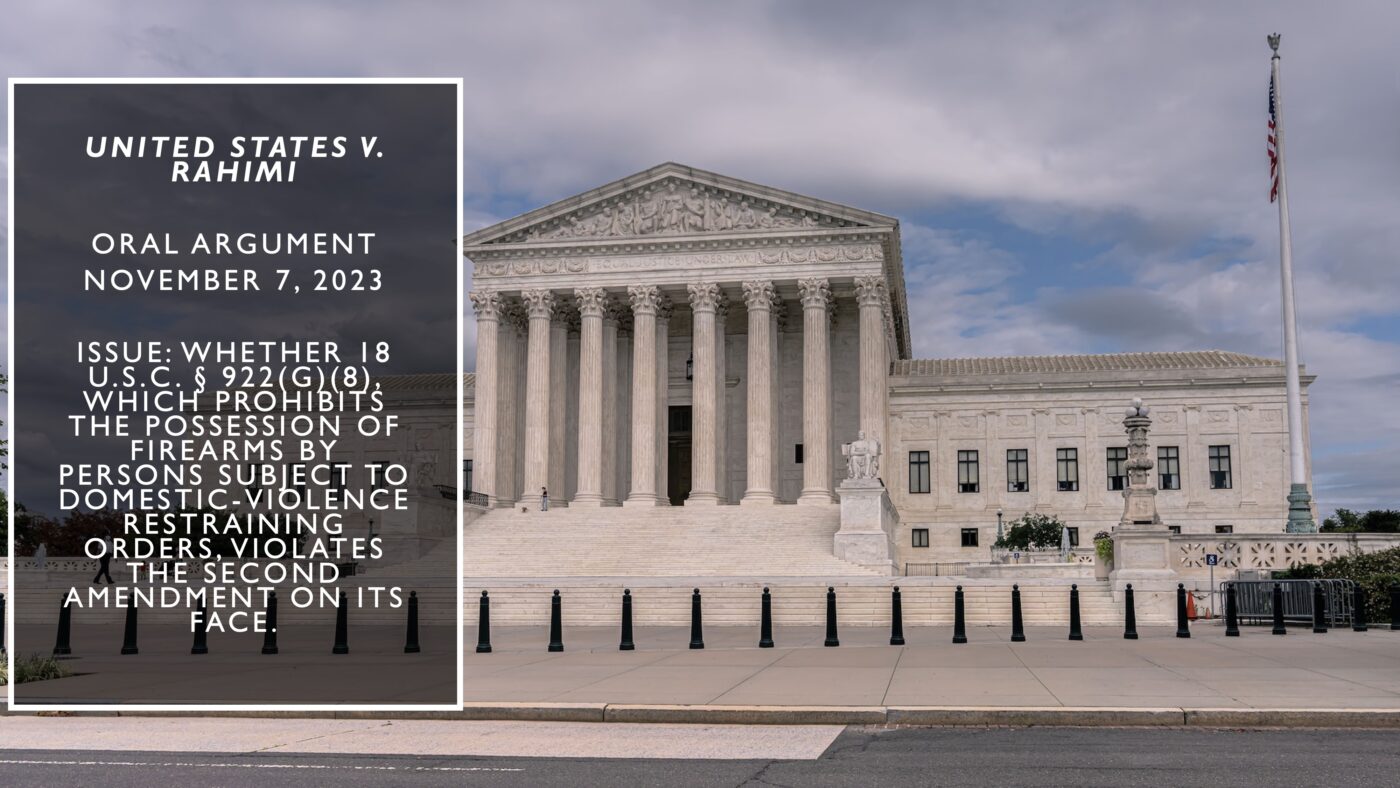United States v. Rahimi (oral argument)
Issue: Whether 18 U.S.C. § 922(g)(8), which prohibits the possession of firearms by persons subject to domestic-violence restraining orders, violates the Second Amendment on its face.
Audio:
https://www.c-span.org/video/?530721-1/united-states-v-rahimi-oral-argument
Summary
The Supreme Court hears arguments in the case of Rahimi, which challenges the constitutionality of 18 USC 922(g)(8), a federal law that disarms individuals subject to domestic violence protective orders. The main issue at hand is whether the law violates the Second Amendment. The government argues that the law is necessary to protect against the danger posed by armed domestic abusers, while the respondent argues that the law is unconstitutional. The Court explores the definitions of law-abiding and responsible citizens, the historical context of disarming dangerous individuals, and the factors that determine dangerousness in domestic violence cases. The Court also addresses the duration and permanence of protective orders, the role of historical analogues in interpreting the Second Amendment, and the methodology used by lower courts in analyzing gun control measures. The conversation in this case revolves around the constitutionality of Section 922(g)(8), which prohibits individuals subject to a domestic violence protective order from possessing firearms. The discussion covers topics such as the distinction between facial and as-applied challenges, the historical tradition of disarming dangerous persons, and the due process rights involved in protective order proceedings. The court explores the scope of disarming dangerous persons and the potential implications of the arguments presented. Ultimately, the court must determine whether Section 922(g)(8) violates the Second Amendment.
Takeaways
- The government argues that Section 922(g)(8) is necessary to protect against the danger posed by armed domestic abusers.
- The Court explores the definitions of law-abiding and responsible citizens and their relevance to the Second Amendment.
- The Court considers the historical context of disarming dangerous individuals and the factors that determine dangerousness in domestic violence cases.
- The Court addresses the duration and permanence of protective orders, the role of historical analogues in interpreting the Second Amendment, and the methodology used by lower courts in analyzing gun control measures. The court must consider the distinction between facial and as-applied challenges when analyzing the constitutionality of a statute.
- The historical tradition of disarming dangerous persons is a key factor in determining the constitutionality of firearms regulations.
- Due process rights play a significant role in protective order proceedings and the disarmament of individuals subject to such orders.
- The court must balance the individual’s right to possess firearms with the government’s interest in preventing domestic violence and protecting public safety.
Helpful Resources:
- https://www.scotusblog.com/case-files/cases/united-states-v-rahimi/
- https://www.oyez.org/cases/2023/22-915
Chapters
00:00 Introduction
00:58 Congressional Disarmament of Domestic Abusers
02:20 The Fifth Circuit’s Error
05:59 Defining Law-Abiding and Responsible Citizens
06:27 Responsibility and Danger
09:28 Determining Dangerousness
11:46 Historical Attitudes Towards Domestic Violence
16:11 Challenges to Protective Orders
17:35 Mutual Protective Orders
18:53 Recourse and Due Process
20:32 Duration of Protective Orders
22:23 Presumption of Regularity in Protective Orders
23:11 Law-Abiding and Responsible Citizens
24:43 The Use of ‘Responsible’ in the Argument
26:55 Methodological Errors in Bruin
29:37 Disarming Dangerous Individuals
31:03 Recourse and Collateral Challenges
32:34 Guidance for Lower Courts
35:23 Clarifying the Law-Abiding and Responsible Citizen Category
37:02 Facial Challenge and As-Applied Challenges
38:14 Legislator’s Perspective
42:32 Methodological Errors in Bruin
44:17 Considering Historical Tradition
45:11 Applying the Bruin Analysis
46:07 Legislator’s Perspective
48:14 Rebuttal
51:03 The Order and Findings
53:13 Facial Challenge and Due Process
54:34 The Scope of the Statute
55:31 The Gun-Free School Zones Act
56:20 The Thinness of the State Court Proceedings
57:08 Due Process and Underlying Felony Prosecution
57:34 Per Se Automatic Disarmament
58:39 Due Process and Protective Orders
59:09 The Scope of Due Process
59:52 The History and Tradition Test
01:01:16 Finding Historical Analog
01:02:15 The Government’s Reply
01:04:05 The Right to Keep Arms
01:05:29 Severe Criminal Punishment
01:06:47 Restraining Orders and Handgun Licenses
01:08:12 Disarming Dangerous Persons
01:09:36 Historical Analog and Bans
01:11:30 Bans by the Legislature vs. Court Orders
01:12:58 Culling of Historical Record
01:14:23 Reconstruction Era Sources
01:15:46 Founding Era Sources
01:16:42 Disarming Dangerous Persons
01:19:30 State Court Proceedings
01:20:26 Effect of the Order
01:21:11 Automatic Disarmament
01:22:38 Effect on Background Check System
01:25:23 Suspension of Handgun License
01:26:14 Individualized Findings of Dangerousness
01:27:41 Historical Analog for Disarmament

